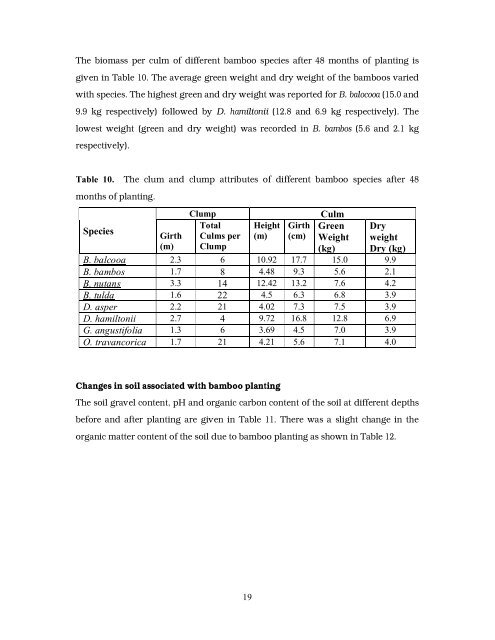Multilocational field trials for selected bamboo species
Multilocational field trials for selected bamboo species
Multilocational field trials for selected bamboo species
You also want an ePaper? Increase the reach of your titles
YUMPU automatically turns print PDFs into web optimized ePapers that Google loves.
The biomass per culm of different <strong>bamboo</strong> <strong>species</strong> after 48 months of planting is<br />
given in Table 10. The average green weight and dry weight of the <strong>bamboo</strong>s varied<br />
with <strong>species</strong>. The highest green and dry weight was reported <strong>for</strong> B. balocooa (15.0 and<br />
9.9 kg respectively) followed by D. hamiltonii (12.8 and 6.9 kg respectively). The<br />
lowest weight (green and dry weight) was recorded in B. bambos (5.6 and 2.1 kg<br />
respectively).<br />
Table 10. The clum and clump attributes of different <strong>bamboo</strong> <strong>species</strong> after 48<br />
months of planting.<br />
Clump<br />
Culm<br />
Total Height Girth Green Dry<br />
Species<br />
Girth Culms per (m) (cm) Weight weight<br />
(m) Clump<br />
(kg) Dry (kg)<br />
B. balcooa 2.3 6 10.92 17.7 15.0 9.9<br />
B. bambos 1.7 8 4.48 9.3 5.6 2.1<br />
B. nutans 3.3 14 12.42 13.2 7.6 4.2<br />
B. tulda 1.6 22 4.5 6.3 6.8 3.9<br />
D. asper 2.2 21 4.02 7.3 7.5 3.9<br />
D. hamiltonii 2.7 4 9.72 16.8 12.8 6.9<br />
G. angustifolia 1.3 6 3.69 4.5 7.0 3.9<br />
O. travancorica 1.7 21 4.21 5.6 7.1 4.0<br />
Changes in soil associated with <strong>bamboo</strong> planting<br />
The soil gravel content, pH and organic carbon content of the soil at different depths<br />
be<strong>for</strong>e and after planting are given in Table 11. There was a slight change in the<br />
organic matter content of the soil due to <strong>bamboo</strong> planting as shown in Table 12.<br />
19

















